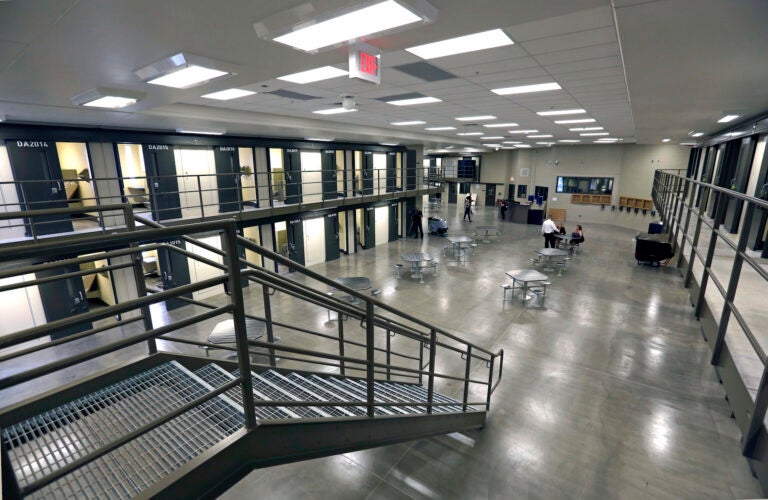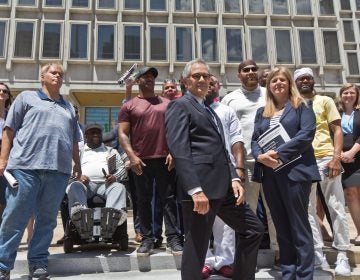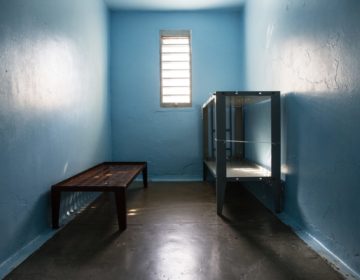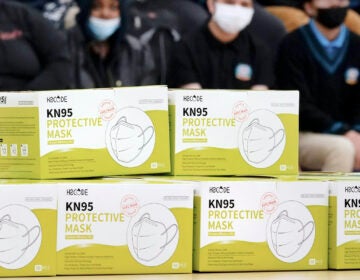‘More harm than good’: Most Pa. prisoners are vaxxed, but isolating COVID rules remain
More than 75% of the people incarcerated in Pennsylvania prisons are fully vaccinated against COVID-19, but only 22% of corrections staff have gotten the shots.

This June 1, 2018, file photo shows a housing unit in the west section of the State Correctional Institution at Phoenix in Collegeville, Pa. (AP Photo/Jacqueline Larma, File)
Vaccination rates are rising among people incarcerated in Pennsylvania prisons, and case rates are falling. But a number of the system’s COVID-19 prevention measures are still in place, and prisoner advocates and family members say they seem to be outlasting their usefulness.
When the pandemic first hit, prisons locked down completely. Virtually all the activities many incarcerated people are allowed to do — going to the prison library, doing various jobs, taking classes, going outside to the yard — were suspended, creating what advocates said was near-solitary confinement.
Martha Williams’ 25-year-old son, Damir Williams, is at State Correctional Institution Albion in Erie County.
Damir was sentenced to life without parole two years ago after a conviction for second-degree murder — a jury found him guilty of choking an elderly man during a robbery. The man later died of pneumonia, and a medical examiner ruled that it was caused by the incident. Williams believes he was wrongly convicted.
Martha, who works with the Coalition to Abolish Death By Incarceration, says the normal stress of having a child locked up and far from home skyrocketed during the pandemic, when information about what was going on inside was limited. As cases kept breaking out in prisons around the state, she worried constantly that he’d get sick.
She says things are a little better now. The Pennsylvania Department of Corrections has a new video-calling system in place, so she can see her son’s face with some regularity. But the things he tells her about his day-to-day life deeply concern her.
“They’re getting now maybe an hour a day” out of the cell, she said. “By the time you shower and you check your tablet for your email and make a phone call, that’s that.”
‘More harm than good’
DOC has said that it’s beginning to roll back restrictions. In-person visits have resumed at six prisons, and visits at five others are scheduled to resume this month and next — including Albion and SCI Phoenix in Montgomery County. But the department has publicly shared little information about the extent of the lockdowns at each of its 23 prisons.
“The best that we understand is that the department is giving a lot of discretion to each facility,” said Kirsten Cornnell, social services director at the Pennsylvania Prison Society, which serves as an unofficial ombudsman for families of incarcerated people in the commonwealth.
“I think we get calls on a daily basis from loved ones that are concerned about access to programming, access to visit, phone calls, shower time, all of this type of thing,” she added. “But it’s really hard to give a clear, consistent answer about what’s happening.”
Cornnell notes, different prisons can have vastly different physical layouts. In some, it may be easier to create pods to keep viruses from spreading, and in others, there are fewer small common areas. But she says across the system, one thing seems clear: while she believes DOC generally “did a really good job mitigating the spread” of COVID-19, their safety measures don’t seem to be keeping pace with rising vaccination rates among incarcerated people.
“These lockdown procedures are causing more harm than they are good,” she said. “There’s real concerns about mental health. And I don’t think we’ll really understand the toll of this last year for a long time.”
Maria Bivens, a spokeswoman for DOC, concedes that things aren’t back to normal yet, and says select COVID-19 changes may well be permanent in certain prisons. Many facilities, for instance, have been serving prisoners their meals in their cells for more than a year, and Bivens said some may continue indefinitely.
She also said the system plans to continue a practice that keeps prisoners in separate groups that never cross paths. It’s a system, she said, that is designed to increase “the amount of time that inmates have out of cell for recreational opportunities, programs, education and vocational programs.”
She didn’t say whether dramatically reduced out-of-cell time like Williams described is still happening — just that “each facility is responsible to set an operational schedule and each will be reviewed and approved by DOC leadership,” and that this schedule “is being carefully coordinated and implemented in a controlled, measured, and meaningful way.”
She noted, DOC is starting to bring some prison volunteer programs back.
“Many facilities have begun that transition now and we are extremely excited about this milestone,” she said.
Across the system, DOC reports that 77% of the people incarcerated in state prisons are fully vaccinated against COVID-19 — above the number many states and cities used as a benchmark for full reopening. Only 22% of corrections staff say they’ve gotten their shots, however.
Cornnell sees that as an obvious problem.
“We have a lot of concerns about how that may impact reopening,” she said. “It’s the staff that are going out into the community and coming back into the facility, and that’s the most likely person to expose the vulnerable, incarcerated population.”
The Pennsylvania State Corrections Officers Association has been urging its members to get vaccinated. John Eckenrode, who heads the union, notes that three of his members died, and estimates some 3,900 of the roughly 10,000 members contracted COVID-19.
He thinks the actual number of fully vaccinated prison workers is likely higher than 22%, but adds, he also thinks the state could have done more to allocate doses directly to corrections workers in the early days of the pandemic.
He adds ruefully, many workers are hesitant to get it, even now that vaccines are readily available.
“I think that no matter what kind of demographic you look at, there’s vaccine hesitancy among all groups,” he said. “[The vaccine] was approved under experimental conditions, and I believe that it should be an individual choice.”
DOC reports that 138 prisoners have died of COVID-19 and more than 11,000 have gotten the virus. There are about 37,000 people incarcerated in the system overall.
‘Highly traumatizing and dangerous situation’
Among family members, like Martha Williams, there’s frustration about the vaccination imbalance, and impatience to get back to in-person visits.
DOC has not said staff vaccination rates are a factor in loosening rules, but overall case rates are. Williams says, to her, it seems obvious that infections introduced by staff are “probably one of the biggest things that will hold up the reopening.”
Lorraine Haw, who advocates with Williams, and whose son, Phillip Ocampo, is serving life in prison without the possibility of parole for his role in a 1994 robbery, feels similarly.
“What’s the point of vaccinating the insiders if the staff aren’t vaccinated?” she asked. “It’s not the insiders that are going in and out of prison. It’s the staff. So if anything is coming in, it’s coming in through the staff.”
Family members say DOC’s new video-chatting system has helped lessen the strain of not being able to see their kids. But note it came with significant drawbacks.
When Williams tried to get a bunch of family together to see her son for his recent 25th birthday, she says the whole thing was a debacle.
“It was an embarrassing nightmare,” she said. “You can’t hear, the quality is poor, your visit is for 45 minutes and you’re spending 35 saying, “Hello? Can you hear me? Do you see me?’”
Problems like these, and the lack of a firm reopening timeline, led the criminal justice reform group Decarcerate PA to send a letter to DOC Sec. John Wetzel this week urging him to rethink the remaining COVID-19 safety precaution for the sake of prisoners’ mental health.
Nomi Teutsch was one of the signers. She’s a social worker who often deals with formerly incarcerated people and the families of people currently in prison.
“I just see how devastating the impact of incarceration is on mental health to begin with, both while they’re behind bars and afterwards,” she said. “That was true before COVID, but the increased social isolation, the lack of access outdoors … the unpredictability of when they’ll be able to connect with their loved ones, not being able to see them in person, all of that contributes to an even more highly traumatizing and dangerous situation.”
DOC spokesperson Bivens says the department isn’t giving a timeline for opening other prisons, or the specific benchmarks it’s requiring in order to lift restrictions. She says it depends on “vaccination rates, overall percentage of positive cases,” and the results of sewage testing for the presence of COVID-19.
Williams has been waiting with bated breath.
She takes a bus, chartered by the Prison Society, when she visits her son. The journey takes more than eight hours. Late on Thursday, she finally got some clear information about when she’ll be making the trip again: Visits at SCI Albion are slated to resume on June 28.
“As soon as the prison is open and they have a bus, I will be on the first thing smokin’,” she said. “This has been rough. It’s been really, really rough.”
 WHYY is one of over 20 news organizations producing Broke in Philly, a collaborative reporting project on solutions to poverty and the city’s push towards economic justice. Follow us at @BrokeInPhilly.
WHYY is one of over 20 news organizations producing Broke in Philly, a collaborative reporting project on solutions to poverty and the city’s push towards economic justice. Follow us at @BrokeInPhilly.

Get daily updates from WHYY News!
WHYY is your source for fact-based, in-depth journalism and information. As a nonprofit organization, we rely on financial support from readers like you. Please give today.







